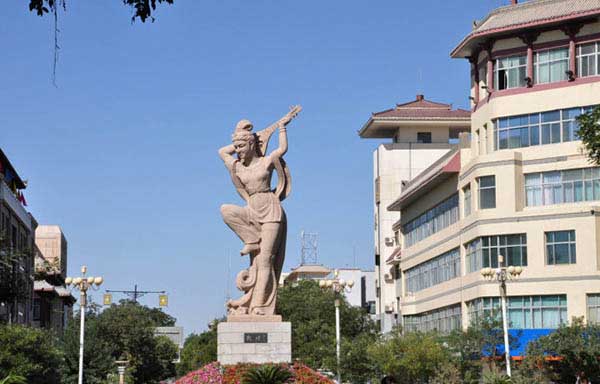- By admin
- In dunhuangknowledge
- 2016-05-14
The six top adventures in Dunhuang
With nothing but 1.3 million-square-kilometer desert for company, Dunhuang (敦煌) really feels as though it's in the middle of nowhere.
But it's the desolation that makes the desert town so attractive.
The air is crisp; there's not the slightest hint of light pollution at night; it’s one of the few places in the world where anyone can rent a camel and camp out in sand dunes.
With a population of 180,000, Dunhuang (the name means "big and grand") is located in the Gansu province of western China.
As a town, it was a frontier defensive bulwark in the Han Dynasty and a major stop on the ancient Silk Road.
The city's history dates to approximately 2000 BC.
Today, the wildest activities in and around the old trading hub revolve around accessing the desert that travelers once feared.
1. Horseback riding to Yangguan Pass

This fortress once marked the border between China and uncharted Western land.
A textbook staple for Chinese students, the Yangguan Pass was immortalized in Chinese history by Wang Wei (王维), a Tang Dynasty poet.
The pass once protected Dunhuang from invaders coming from the west; and though it has been reduced to a heap of rock with traces of design and architectural details, the view near the pass remains breathtaking: bleak but beautiful desert stretches as far as the eye can see.
Admission is RMB 50 (US$8), which includes a guided tour of the Yangguan Museum.
Visitors have the option of going up to the Yangguan Pass on a tram or by horseback. The horse, of course, feels far more epic.
2. Hiking amid eerie rock formations at Yadan National Park

Mission in Yadan: spot the rock formations that resemble the Sphinx.
Yadan National Park is spead over 400 square kilometers and littered with various rock formations that are analogous to abstract art -- they're actually the product of lake erosion millions of years ago.
Now arid desert, the entire area was once underwater.
Visitors can jump on a tour bus to various sites with rocks that resemble the Egyptian sphinx, Great Pyramids and ancient Roman relics.
Awesome photo ops are everywhere. Nothing says desert nomad more than a midair jumping photo in the middle of nowhere.
Yadan National Park (敦煌雅丹国家地质公园), 180 kilometers northwest of Dunhuang.
3. Touring Mogao Grottoes

The Mogao Grottoes are a series of Buddhist caves with amazing detailing.
There are 492 caves that contain some 2,100 colored statues and 45,000 square meters of murals. If joined together, they would cover a length of 30 kilometers, or the equivalent of 1,000 basketball courts.
Staff and tour guides are adamant about enforcing the area's photography ban. Bags have to be checked in before their owners can embark on the hour-long tour.
The grottoes are a UNESCO World Heritage Site and each cave has its own unique character.
The area was a pilgrimage site and venue for ancient scribes. The fact that it's intact today (after the destruction of so many other historic sites in China) is testament to its cultural value.
Admission is RMB 180 ($28) during high season (May 1-October 31) and RMB 100 ($15) the rest of the year.
Related destinations
Why Choose Us?
We are the top Silk Road tour operator based in Dunhuang, China. We focus on providing well designed Silk Road China Tours with resonable price and thoughtful service.
- Easy & carefree booking
- The best value
- Great travel experience
- Locally operated
Hot Tours
-

6 days Gansu tour to Binglingsi, Xiahe and Langmusi
Tour type : Private tour Price : from *** Destinations : Lanzhou - linxia - Xiahe - Langmusi - Hezuo - Lanzhou -

12 Days Gansu Highlights Tour
Tour type : Private tour Price : from *** Destinations : Xian – Tianshui – Lanzhou – Xiahe – Langmusi – Hezuo – Zhangye – Jiayuguan - Dunhuang -

10 Days Silk Road Classic Tour
Tour type : Private tour Price : from *** Destinations : Xian - Zhangye - Jiayuguan - Dunhuang - Turpan - Urumqi -

5 Days Zhangye - Alxa youqi Highlights Tour
Tour type : Private Tour Price : from *** Destinations : Zhangye - Alax youqi - Zhangye


